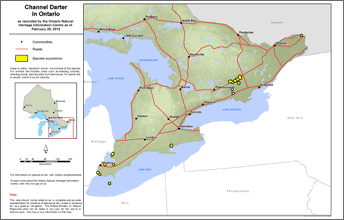Channel darter
Scientific name: Percina copelandi

Photo: George Coker
Status
Special concern
“Special Concern” means the species lives in the wild in Ontario, is not endangered or threatened, but may become threatened or endangered due to a combination of biological characteristics and identified threats.
Date added to the Species at Risk in Ontario List
The Channel Darter was already assessed as threatened when the Endangered Species Act took effect in 2008. The species was reassessed as special concern in May 2017.
Read the assessment report PDF.
What it looks like
The Channel Darter is a small member of the perch family. This tiny fish grows to between three and seven centimetres in length. It has a light sand or olive-coloured body with brown speckles on the back, dark cross-shaped markings or oblong blotches on its sides, and a whitish belly. The fins may be lightly speckled but are usually clear. Although the Channel Darter looks similar to other darter species, particularly the more common Johnny Darter, experts can tell these two fish species apart by looking at the small spines on the anal fin near the tail.
Where it lives
In Ontario, the Channel Darter lives in clean streams and lakes with sandy or gravel bottoms. During the breeding season in late spring, it prefers riffle areas with fairly fast moving water but spends the winter in deeper, calmer water. It eats mostly aquatic insect larvae from the bottom of the stream.
Where it’s been found in Ontario
In Canada, the Channel Darter only lives in Ontario and Quebec. In Ontario, it is found in several locations from the St. Clair and Detroit rivers to Lake Erie, and in tributaries of eastern Lake Ontario and the St. Lawrence and Ottawa rivers.
View a larger version of this map (PDF)
What threatens it
In Ontario, the main threat to the Channel Darter is poor habitat quality. This species likes clean, clear water and does not do well in rivers that are muddy or polluted. In many streams where this fish lives, the water is becoming muddy due to soil washing into the river from nearby urban and agricultural areas. Invasive fish species that compete with the Channel Darter for food are also a threat.
Action we are taking
Special concern species do not receive species or habitat protection, but may be eligible for grants to help with their protection and recovery.
Recovery strategy
A recovery strategy advises the ministry on ways to ensure healthy numbers of the species return to Ontario.
Read the recovery strategy (December 14, 2016)
Government response statement
A government response statement outlines the actions the government intends to take or support to help recover the species.
Read the government response statement (September 12, 2017)
Review of progress
A review of progress made toward protecting and recovering a species is required no later than the time specified in the species’ government response statement, or not later than five years after the government response statement is published if no time is specified.
Read the report on progress towards the protection and recovery of 12 species at risk, including Channel Darter (2022).
What you can do
Report a sighting
- Report a sighting of an endangered animal or plant to the Natural Heritage Information Centre. Photographs with specific locations or mapping coordinates are always helpful.
Volunteer
- Volunteer with your local nature club or provincial park to participate in surveys or stewardship work focused on species at risk.
Be a good steward
- Private land owners have a very important role to play in species recovery. If you find Channel Darter in a watercourse on or adjacent to your property, you may be eligible for stewardship programs that support the protection and recovery of species at risk and their habitats.
- Invasive species seriously threaten many of Ontario’s species at risk. To learn what you can do to help reduce the threat of invasive species, visit:
- Farmers and land owners can help improve fish habitat and keep Ontario’s water safe and clean by maintaining natural vegetation next to creeks and rivers, and keeping pollution and soil from washing into Ontario’s rivers. You can find more information about programs and funding assistance for eligible farmers from the Ontario Soil and Crop Improvement Association website.
Report illegal activity
- Report any illegal activity related to plants and wildlife to
1-8766-MOE-TIPS (663-8477) .
Quick facts
- The sandy colour of the Channel Darter provides perfect camouflage with the sandy river and lake bottoms where it lives.
- When breeding, the male’s body and fins may turn dark and his head may become almost black. Breeding males also set up and vigorously defend a small territory that is usually centred around one special rock.
